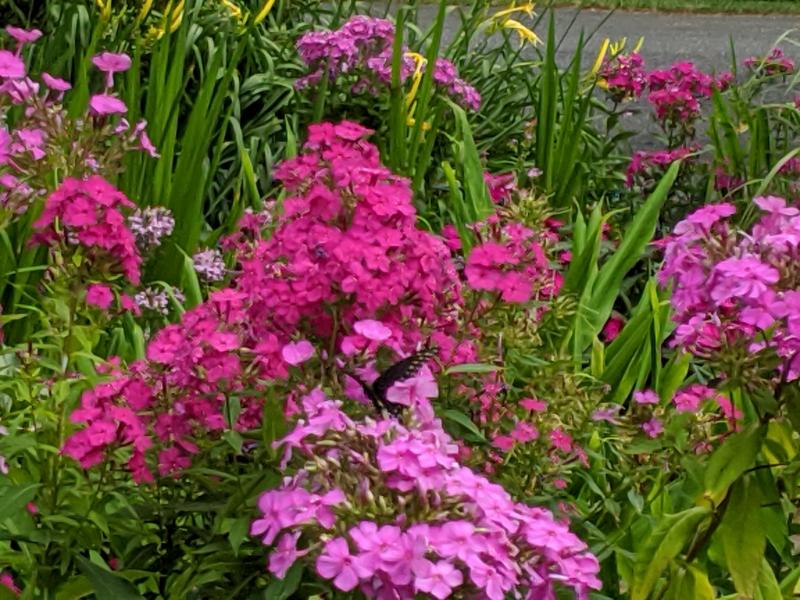Mill Pond Garden will celebrate the high summer garden’s mainstays – hydrangeas, phlox and lilies – from 10 a.m to 12:30 p.m., Sunday, June 27. For tickets, go to millpondgarden.com.
Summer gardens in the Cape Region are enlivened by the color of these traditional plants. For this open garden day, there also will be blooming daylilies, crocosmia, water lilies, roses, hibiscus, lavender, crape myrtles and more.
Hydrangeas comprise shrubs of many types. The Hydrangea arborescens is native to eastern north America. New cultivars, particularly the Incrediball, may bear huge white flowers. The non-native hydrangeas are noninvasive and provide benefit for pollinators, so they can be planted locally in good conscience. The trunk type hydrangea paniculata and the native arborescens like full sun to part shade, whereas the popular colored hydrangea macrophylla prefer shade to part shade.
Among the multi-stem types of hydrangea there are two flower shapes, the mop head, which is round, and the lace-cap, which is flat. All the paniculata and oak-leaf hydrangeas have pointed, cone-shaped flowers.
Hydrangeas bloom locally from about mid-June to late October or longer, going through color changes. Sometimes their big round flower heads even look good through winter when the sun has bleached them to a pleasant straw color.
Most hydrangeas – ones with many canes from the ground instead of a trunk with branches – are best supported using a sturdy stake inside the shrub with a strong cord looping out to secure the many canes so the plant does not sag under the weight of its large, heavy flowers. Hydrangeas can be from five feet across and high to 10 feet high and wide. Some hydrangeas feature good fall foliage color, even to deep maroon.
Most hydrangea flowers are white, with some pinks to purples. The European species macrophylla, the most popular, sports blue, pink, red or purple flowers, with the color determined partly by breeding but more by soil acidity or alkalinity (pH). Acidic soil makes blue flowers, and alkaline soil makes pink flowers. It is best to fix the pH of soil before planting for quickest results.
Peat moss or powdered sulfur mixed in the planting soil will make it more acid, while dolomitic limestone added in will make the pH more alkaline. The planting soil should be heavily amended with organic compost to buffer the pH and keep it stable as well as to make the plant prosper. Mill Pond Garden recommends and uses only composted horse manure, but not-too-old yard compost may do nearly as well, or leaf mold. Hydrangeas provide the anchor of summer color, and few shrubs or flowering plants can equal their longevity of display.
Tall phlox, a native American perennial plant, is another summer garden staple which Mill Pond garden recommends highly since it flowers from mid-June to late September. It is also one of the best magnets for pollinators. Phlox is also deliciously fragrant, especially in masses. Phlox come in short, medium and tall, 18 inches to four feet high, and in all colors except yellow, including violet, white, red, pink, purple, blue and orange.
Mill Pond Garden recommends gardeners select only varieties with excellent ratings for resistance to powdery mildew disease. Mill Pond Garden has participated with Ohio State University in phlox research and has trialed many cultivars.
For local best performance, Mill Pond Garden’s choices of named phlox varieties include Nicky, Bright-Eyes, Laura, Delta Snow, Bubblegum Pink, Dick Weaver, Jeana, David, Glamour Girl and Nora Leigh. No other perennial flowering plant performs as long or as well as tall phlox. Phlox likes good drainage, compost-enriched soil, good air circulation and at least six daily hours of direct sun. The only insect pest can be spider mites, which are easy to dislodge with a jet spray of hose water to the plants’ undersides perhaps every few weeks.
Lilies, though short blooming, about 10 days, are so spectacular in size, shape and often strong fragrance that they make great accent plants. A succession of early, middle and late-season blooming types can be planned to start about early June and last into mid-August. Mill Pond Garden recommends the hybrid orienpet types, also called tree lilies, since their sturdy stems do not need to be staked and tied.
Lilies like sunny, well-drained sites with compost-enriched soil. Plant the bulbs about six to eight inches deep in early spring or mid- to late fall in the Cape Region. Lilies rot if over-watered or if in wet soil, but also do not like to get overly dry. Water only in drought. Mill Pond Garden’s best-performing lilies include: Conca d’Or, Purple Prince, Levern Friemann, Pretty Woman, Anastasia, Forever Susan, Lavon, Casa Blanca, Salmon Star, Muscadet and Scheherazade.
Choosing plants for any garden is aided by visiting other gardens in the area to see how various plants perform. Providing a reference for good performance is part of the educational mission of a public garden, which also includes a place to get inspiration, ideas about design and plant choices, and useful horticultural information. Mill Pond Garden is a small botanical garden on Red Mill Pond outside Lewes.






















































